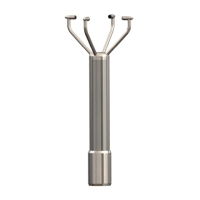Gill Instruments Ltd
_____________________________________________________________________________________________________________
________________________________________________________________________________________________
WindObserver 65 Page 23 Issue 4
Doc. No. 1390-PS-0039 June 2016
6.9. Mechanical installation
Do NOT remove the black “rubber” transducer caps.
Take care not to knock the four Transducer arms.
Before installing, a bench system test is recommended.
All the time the WindObserver 65 is not in its final location, it should be
protected from damage by keeping it in the original packaging as long as
possible, treating it as a delicate instrument.
When installing the unit handle with lint free gloves and degrease the unit to
reduce the build-up of deposits.
Do not apply clamps to the WindObserver cylinder body as this will distort
the cylinder and affect sealing.
Location
It is important to ensure that the WindObserver 65 is mounted in a position clear of any
structure, which may obstruct the airflow or induce turbulence.
Do NOT mount the WindObserver 65 in close proximity of high-powered radar or radio
transmitters. A site survey may be required if there is any doubt about the strength of
external electrical noise. (See Section 6.1)
Orientation
Normally the WindObserver 65 is mounted vertically with the cable exit at the bottom.
Alternatively, the unit may be mounted in any orientation, but note that if the unit is
mounted with the cable uppermost, the base must be fully sealed externally to prevent
water penetration. Fit the supplied gasket if the 2 metal mounting faces are of dissimilar
metals to prevent galvanic corrosion.
Mounting bracket (Short and Long Mounts)
A suggested mounting bracket using Short or Long Mounts is shown in Fig 1.
It is recommended that the WindObserver 65 mounting bracket be manufactured from
stainless steel 316, to prevent possible galvanic corrosion.
It is also recommended that the supplied gasket be always fitted to ensure IP66 rating and
to prevent galvanic corrosion if the mounting bracket is not manufactured from stainless
steel 316.
Stainless steel 316 fixings must be used.

